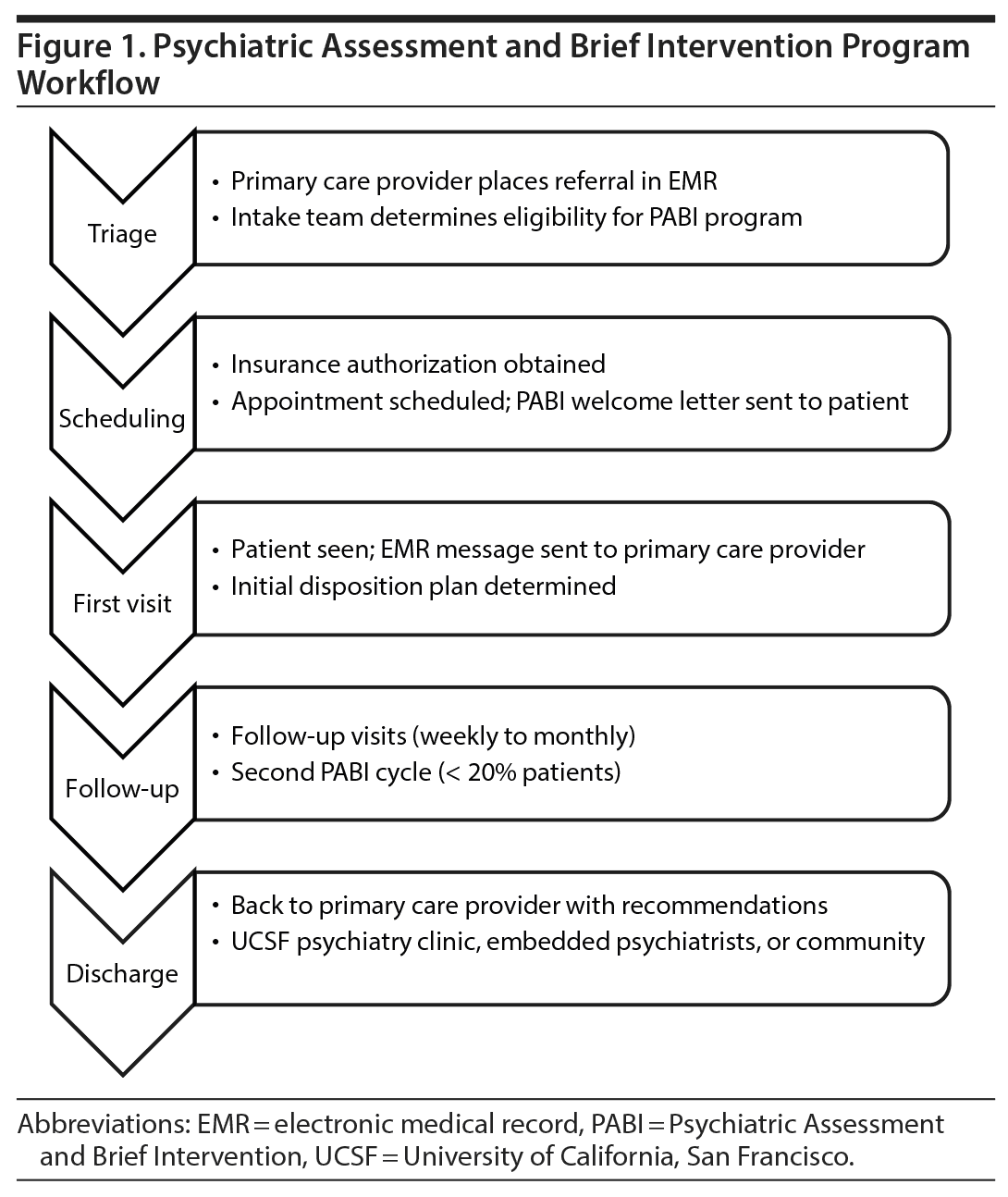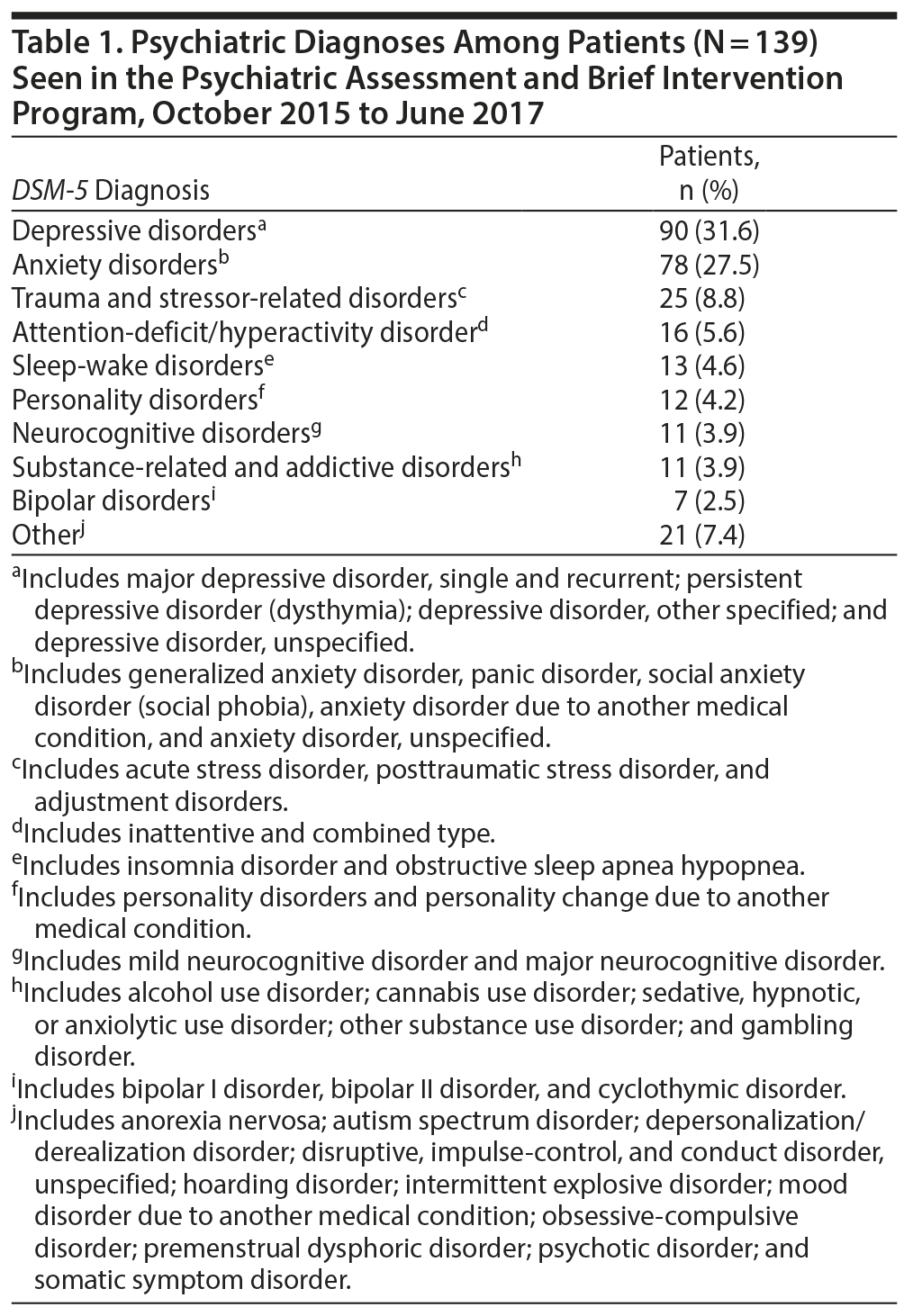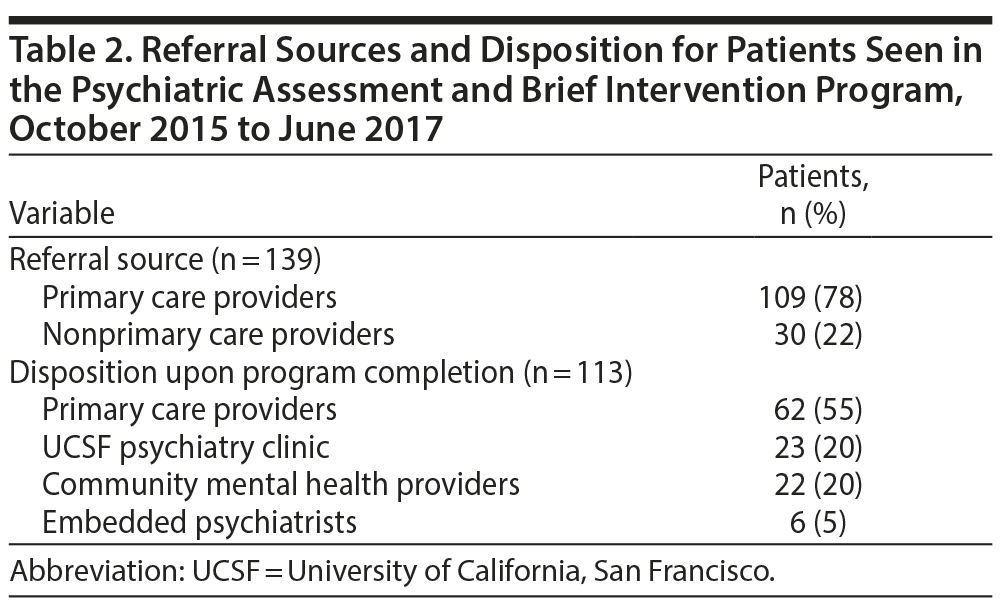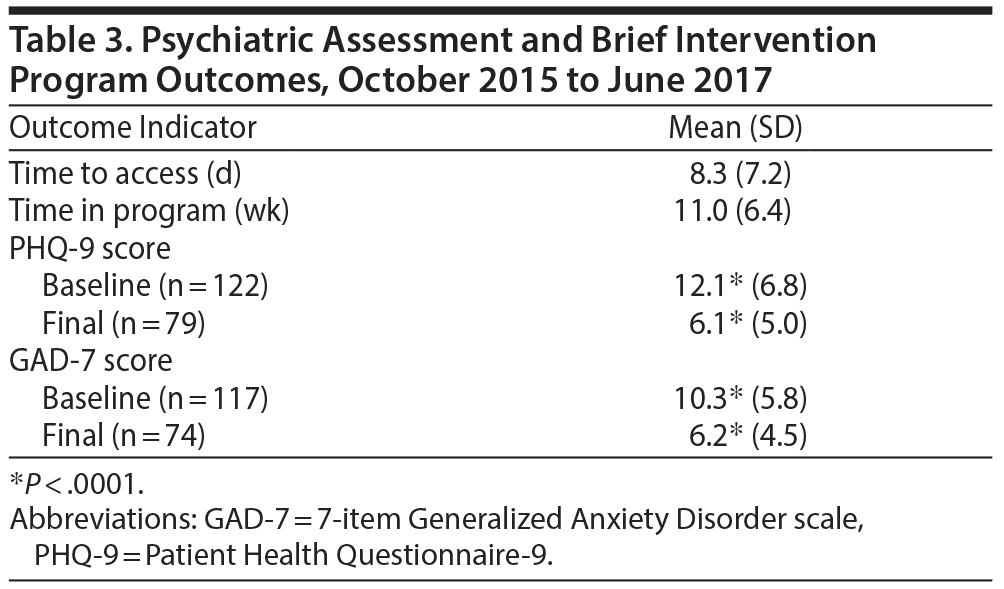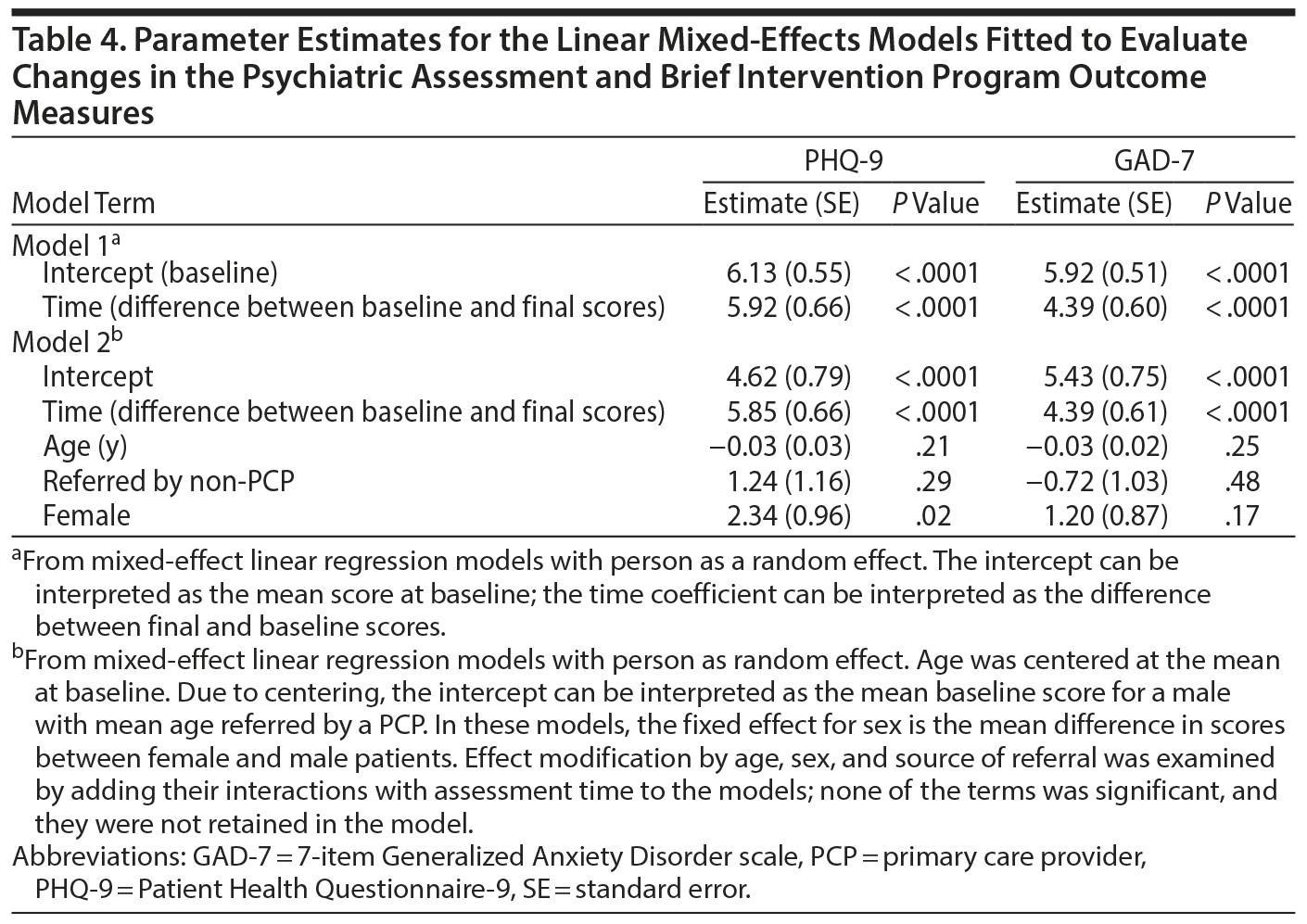Objective: To present the structure and outcomes to date for the Psychiatric Assessment and Brief Intervention (PABI), a pilot program developed at University of California, San Francisco, to improve access of primary care patients to mental health services. PABI offers diagnostic evaluations and brief (up to 3 months) evidence-based treatment, including pharmacologic management and psychotherapy, to medical patients 18 years of age and older. Core PABI features are ensuring prompt access, actively partnering with patients and referring providers, and coordinating seamless transitions of care.
Methods: Demographic and clinical variables and outcome indicators were collected for all patients seen in PABI from October 2015 to June 2017. Descriptive statistics and mixed-effects linear models were used to analyze the data.
Results: During the study period, 139 patients (54% women, mean [SD] age of 48.2 [17.5] years) with a mean of 2 DSM-5 psychiatric diagnoses each (range, 1-5) were seen. Mean time to access was 8 days, with a mean length of stay in the program of 11 weeks. Compared to baseline, final behavioral health measure scores showed significant improvement: the mean Patient Health Questionnaire-9 score decreased by 5.9 points (95% CI, 4.6-7.2), and the mean 7-item Generalized Anxiety Disorder scale score was 4.4 points lower (95% CI, 3.2-5.6; both P values < .0001).
Conclusions: This brief psychiatric treatment program provides prompt access to quality mental health care for patients with medical comorbidities. Results to date suggest that this program leads to significantly improved clinical outcomes. Further research is needed to determine its long-term sustainability and generalizability.
Objective: To present the structure and outcomes to date for the Psychiatric Assessment and Brief Intervention (PABI), a pilot program developed at University of California, San Francisco, to improve access of primary care patients to mental health services. PABI offers diagnostic evaluations and brief (up to 3 months) evidence-based treatment, including pharmacologic management and psychotherapy, to medical patients 18 years of age and older. Core PABI features are ensuring prompt access, actively partnering with patients and referring providers, and coordinating seamless transitions of care.
Methods: Demographic and clinical variables and outcome indicators were collected for all patients seen in PABI from October 2015 to June 2017. Descriptive statistics and mixed-effects linear models were used to analyze the data.
Results: During the study period, 139 patients (54% women, mean [SD] age of 48.2 [17.5] years) with a mean of 2 DSM-5 psychiatric diagnoses each (range, 1-5) were seen. Mean time to access was 8 days, with a mean length of stay in the program of 11 weeks. Compared to baseline, final behavioral health measure scores showed significant improvement: the mean Patient Health Questionnaire-9 score decreased by 5.9 points (95% CI, 4.6-7.2), and the mean 7-item Generalized Anxiety Disorder scale score was 4.4 points lower (95% CI, 3.2-5.6; both P values < .0001).
Conclusions: This brief psychiatric treatment program provides prompt access to quality mental health care for patients with medical comorbidities. Results to date suggest that this program leads to significantly improved clinical outcomes. Further research is needed to determine its long-term sustainability and generalizability.
Prim Care Companion CNS Disord 2018;20(1):17m02221
To cite: Seritan AL, Haller E, Linde P, et al. The Psychiatric Assessment and Brief Intervention program: partnering with primary care providers. Prim Care Companion CNS Disord. 2018;20(1):17m02221.
To share: https://doi.org/10.4088/PCC.17m02221
© Copyright 2018 Physicians Postgraduate Press, Inc.
aDepartment of Psychiatry, University of California, San Francisco, San Francisco, California
bUCSF Weill Institute for Neurosciences, San Francisco, California
cDepartment of Public Health Sciences, University of California Davis, Davis, California
dBaylor Scott and White Health, Temple, Texas
eDepartment of Psychiatry, Texas A&M University Health Science Center, College of Medicine, Bryan, Texas
*Corresponding author: Andreea L. Seritan, MD, 401 Parnassus Ave, Box 0984-APC, San Francisco, CA 94143 ([email protected]).
Almost half of patients seen in primary care settings have psychiatric comorbidities.1 Primary care providers (PCPs) manage 60% of all patients treated for depression and prescribe 79% of antidepressant medications.2 Patients managed in primary care settings may also suffer from other psychiatric conditions—most commonly anxiety and substance use disorders, but also bipolar, personality, and somatic symptom disorders.3,4 Psychiatric comorbidities lead to worse medical outcomes, functional impairments, and greater health services utilization, as well as unnecessary suffering for patients.3-5 An expanding body of knowledge shows that anxiety and depression increase the risk of cardiac disease,5 diabetes mellitus,6 and inflammatory disease.7 Depression has been linked to a heightened risk of neurodegenerative diseases,8 while sleep disorders such as obstructive sleep apnea have been correlated with cognitive deficits.9 All of these findings highlight the need for prompt diagnosis and treatment of psychiatric disorders.
In recognition of gaps in access to mental health care, particularly for patients seen in primary care clinics, the Department of Psychiatry at University of California, San Francisco (UCSF), implemented a series of initiatives to extend the reach of psychiatric services. These initiatives included (1) expanding embedded mental health services (wherein psychiatrists and psychologists are colocated and comanage patients with teams in other UCSF Health clinics) from 3 sites in 2012 to 12 sites by 2016 and (2) developing a pilot program in the outpatient psychiatry clinic (the Psychiatric Assessment and Brief Intervention [PABI]) devoted to brief treatment with an expectation that, once stable, patients return to PCPs for maintenance care. The PABI blueprint was based on a brief treatment clinic model developed at the San Francisco Veterans Affairs Medical Center, following established clinical practice guidelines.10 On the basis of strong evidence supporting the combination of psychotherapy and pharmacotherapy to treat anxiety and depressive disorders, the most common presenting psychiatric diagnoses in the target population,11,12 a 3-month program length was established. This time-limited model allows for a structured psychotherapy course, along with 1 to 2 medication trials.13 The aims of this article are 2-fold: to describe PABI’s structure and workflow and to report program outcomes and lessons learned to date.
METHODS
PABI Program Overview
PABI offers diagnostic evaluations and brief evidence-based treatment, including pharmacologic management and individual psychotherapy (for more information, visit http://psych.ucsf.edu/pabi). The program serves UCSF Health patients 18 years of age and older with a wide array of medical and psychiatric comorbidities. In its first year, PABI was open only to patients referred by PCPs but was later expanded to include referrals from all UCSF clinicians. Supplementary Appendix 1 illustrates the step-by-step program development process.
PABI’s current core team includes a full-time clinical psychologist and 2 part-time psychiatrists (0.2 full-time equivalent each). The psychologist was recruited during the first year; the initial team consisted of 2 psychiatrists who provided both psychotherapy and medication management. To ensure optimal communication, the core team meets weekly for two 30-minute huddles and 1 administrative team meeting. Huddles are clinical meetings held at the beginning of each clinic day, wherein the psychologist meets with each psychiatrist individually to discuss their shared patients’ progress and any therapeutic challenges. Huddles also serve as opportunities for interprofessional teaching. Third-year medical students participate in PABI, which is an ideal setting for learning psychiatric interviewing and diagnostic skills. The team meeting is a forum for collegial discussion, dissemination of new information, and periodic review of patient logs (see Program Outcomes).
A central PABI tenet is partnering with patients and referring providers to deliver individualized, evidence-based treatment, with realistic goals that can be reached in 3 months. Patients are expected to actively participate in their care by attending frequent (often weekly) appointments. Close-the-loop communication with referring clinicians is another important program feature: providers are notified when patients are first seen, after program completion, and as needed in the interim.14,15
PABI Workflow
PABI workflow is illustrated in Figure 1. UCSF Health providers place referral orders. In primary care, behavioral health navigators triage referrals and direct a portion to PABI based on patient needs. Referrals from non-PCPs enter the psychiatry intake work queue directly. The psychiatry clinic intake team consists of 2 social workers who communicate closely with the PABI team. The intake team reviews referrals and conducts brief phone screening interviews with patients before scheduling appointments in PABI or other outpatient psychiatry programs. PABI has clear eligibility criteria, established to ensure that patients can achieve specific treatment goals in 3 months and to preserve scarce system resources (for example, patients who already have a psychiatric provider or access to an embedded psychiatrist are not eligible for medication management in PABI). Additional exclusion criteria, indicating need for higher level of care or a different program, are as follows:
- Active suicidal or homicidal ideation with intent or plan
- Chronic suicidality or multiple suicide attempts in the previous year
- History of violent/assaultive behavior
- Severe or chronic psychosis
- Current heavy substance use.
Once the intake appointment is scheduled, a welcome letter is sent to patients outlining PABI structure and duration to ensure realistic expectations.

- Brief psychiatric treatment programs offering psychotherapy and psychopharmacologic interventions can lead to significantly improved clinical outcomes.
- Prompt patient access to mental health services is imperative, ideally within 2 weeks of referral.
- Active partnering with patients and referring providers, along with seamless transitions of care, are important ingredients of an effective brief psychiatric treatment program.
After the first visit, PABI clinicians send a notification to the referring providers, along with a brief program description. An initial discharge decision and end date are planned at the first visit to encourage the patient-clinician dyad to work toward attainable treatment goals. Most patients engage in split treatment (individual therapy with the psychologist and pharmacologic management with psychiatrists), although some pursue psychotherapy only, while others are referred for medication consultations. Efforts are made to schedule follow-up medication management and therapy visits on the same day for patient convenience, unless prohibited by insurance. PABI uses treatment-to-target principles, wherein clinical outcomes are monitored through evidence-based scales including the Patient Health Questionnaire-9 (PHQ-9)16 and 7-item Generalized Anxiety Disorder scale (GAD-7).17 If the patients’ symptoms have not improved after 3 months or their behavioral health measure scores increased, patients may continue with a second treatment cycle (second cycles occur for only 10%-20% of patients at any given time to maintain access). Patients who need long-term follow-up are referred to the outpatient psychiatry clinic or into the community as appropriate.
Treatment planning is a crucial component of PABI, allowing the judicious use of time. The frequency of follow-up visits is determined by treatment modality and patient acuity; most patients are seen weekly in therapy and every 2-4 weeks for medication management, with more frequent appointments initially. At the end of the treatment cycle, a discharge message is sent to referring providers, informing them of the patients’ status and updated pharmacologic regimen and ensuring they are willing to continue prescriptions. PABI clinicians remain available for consultation to referring providers for up to 6 months. Patients can self-refer back into the program by directly contacting PABI clinicians or may be re-referred by UCSF Health providers as needed.
Psychotherapy in PABI
Cognitive-behavioral therapy is used initially, as it is a well-established successful treatment for anxiety and depressive disorders.18 As patients’ needs, strengths and limitations, degree of motivation, efficacy, and agency are clarified, elements of other approaches may be used in addition to or in lieu of cognitive-behavioral therapy. These modalities, backed by evidence of varying strength, include acceptance and commitment therapy,19 interpersonal therapy,20 mindfulness and relaxation training,21,22 motivational interviewing,23 and problem-solving therapy.24 Brief (time-limited) psychodynamic psychotherapy also has its place in the repertoire of PABI therapists, and clinicians use psychodynamic formulations to conceptualize patients’ core difficulties and guide treatment planning.25,26 Patients are referred to couples or group therapy in the outpatient psychiatry clinic as indicated.
Therapeutic interventions often focus on psychological barriers that hinder the treatment of medical illnesses. For example, a 56-year-old woman with depression and uncontrolled diabetes mellitus had a hemoglobin A1c level of 13.4% 2 months prior to starting PABI. She was referred to PABI after being hospitalized twice for lower extremity cellulitis. Using problem-solving skills and behavioral strategies built on a psychodynamic foundation, the PABI team helped this patient identify and overcome barriers to adherence to the diabetes treatment regimen. At completion of the program, her hemoglobin A1c level was 7.4%.
Systemic Impact
PABI served as a catalyst for change, providing an opportunity to improve several dated processes in the outpatient psychiatry clinic (Supplementary Appendix 1). Based, in part, on data collected in PABI, a Lean27 health care overhaul of the psychiatry clinic’s intake process was implemented in February 2017. Prior to this implementation, referrals sent through the electronic medical record reached unmonitored work queues, which, at times, caused great delays or lack of access due to referrals getting lost. Currently, all referrals are reviewed by the intake team within 1 to 2 business days, resulting in greatly improved access. Additionally, patients who required ongoing psychiatric management after completing PABI had to wait several months to see their next psychiatrist due to general backlogs within the UCSF psychiatry clinic. Another Lean initiative was undertaken in March 2017, resulting in an algorithm to better prioritize referrals to open-ended clinics. PABI was given high priority, thus reducing the wait time for medication management appointments to under a month.
Program Outcomes
Several effectiveness indicators were selected prior to launching PABI. These indicators included process (ie, time to access, time spent in program) and outcome (PHQ-9 and GAD-7 score change) measures. For internal tracking purposes, a patient log is maintained on a password-protected clinical drive that only PABI clinicians can access (Supplementary Appendix 2). Clinicians update the log weekly and review it at team meetings to ensure adequate progression of patients through the program. The following data were collected from the log for this study: patient age, sex, referring provider (PCP, non-PCP), International Classification of Diseases, 10th Edition (ICD-10) codes, date when the intake team called the patient, date of the first visit, date of the last visit, baseline and final PHQ-9 and GAD-7 scores, and disposition at program completion.
Statistical Analysis
Descriptive statistics were used to summarize the data: frequencies (percentages) were calculated for participant demographic characteristics, psychiatric diagnoses, referral sources, and disposition categories, while means and SDs were used for baseline and final PHQ-9 and GAD-7 scores, time to access, and time spent in the program. To make use of all available data, PHQ-9 and GAD-7 scores at baseline and at the end of the program were compared using mixed-effects models28 implemented with PROC MIXED in SAS Version 9.4.29 This approach accounted for the correlated structure of the data due to repeated measures, allowed for missing data, and accommodated heterogeneous variances across assessment times.28 The 2 outcome measures (PHQ-9 and GAD-7) were analyzed separately. A core model was first fitted for each outcome measure, using a main effect for assessment time (baseline or final) and a random effect for individual. Terms for age, sex, and source of referral (PCP, non-PCP) were then added to these core models and tested. Effect modification by age, sex, and source of referral was examined by adding their interaction with assessment time to the models. Model assumptions were validated both graphically and analytically. Sensitivity analyses were conducted by comparing baseline and final scores for only those patients with complete data pairs (n = 77 for PHQ-9 and n = 71 for GAD-7, respectively), using paired t tests. This study was deemed exempt by the UCSF Institutional Review Board and received no funding support.
RESULTS
From October 2015 to June 2017, 139 patients were seen in PABI: 64 (46%) men and 75 (54%) women. The mean (SD) age was 48.2 (17.5) years (range, 18-93). In the overall group, 284 psychiatric diagnoses were recorded, for a mean of 2 disorders per patient (range, 1-5). Table 1 summarizes psychiatric diagnoses converted to DSM-5 terminology. Forty-five (37%) patients had baseline PHQ-9 scores ≥ 15, consistent with moderately severe to severe depression, and 33 (28%) had baseline GAD-7 scores ≥ 15, indicating severe anxiety. Every PABI patient had at least 1 co-occurring medical condition, including cardiovascular disease, cerebrovascular disease, diabetes mellitus, hepatic disease, hyperlipidemia, hypertension, varied neurologic conditions, and renal disease. Two patients were hospitalized for suicidal ideation, and 17 (12%) continued for a second cycle. No patients returned for additional treatment during the study period.
Table 2 depicts the referral sources for all PABI patients and disposition plans for the 113 patients who completed the program during the study period (the others were still in treatment). Of the patients returned to their PCPs, 5 were seen in practices in which PABI psychiatrists also worked in embedded roles, readily available for consultation. PABI clinicians provided 1,580 visits during the study period, accounting for 6.3% of all outpatient psychiatry clinic visits. No-show rates were 3% for initial appointments and 10% for follow-ups. There were no dropouts from care.
Table 3 summarizes PABI program outcomes to date, including time to access (time between the intake team’s call and the first visit in days, including weekends and holidays), time spent in the program (time between the first and last visit in weeks), and PHQ-9 and GAD-7 scores. Table 4 summarizes the mixed-effects analyses. Unadjusted analyses (model 1) showed significant score reductions for both PHQ-9 (by 5.9 points; 95% CI, 4.6-7.2) and GAD-7 (by 4.4 points; 95% CI, 3.2-5.6) by the end of the program compared to baseline (both P values < .0001). These results were maintained after adjusting for age, sex, and referral source (model 2). None of the interactions between time and age, sex, or referral source reached statistical significance. Sensitivity analyses revealed similar results: final score reductions for both PHQ-9 (by 5.9 points; 95% CI, 4.5-7.3) and GAD-7 (by 4.8 points; 95% CI, 3.5-6.1) compared to baseline (both P values < .0001). Patient feedback has been positive so far, although this information has not been systematically collected. Referring providers also offered informal feedback, expressing satisfaction with the prompt access and specialty support.
DISCUSSION
This data-driven report describes a brief psychiatric treatment program developed in a tertiary care psychiatry outpatient setting to help improve access to mental health services for primary care patients. Results to date support this pilot program’s effectiveness and will be used to inform plans for further expansion. PABI could also serve as blueprint for other institutions seeking to develop similar programs. Data collected during PABI’s first 2 years of operation showed significant improvements in patient outcome measures, attained in relatively short periods (mean of 11 weeks). Although final scores were still in the range of mild depression (PHQ-9: 6.1) and mild anxiety (GAD-7: 6.2), respectively, the PHQ-9 mean score was reduced by 5.9 points, and the GAD-7 mean score was 4.4 points lower compared to baseline. A score difference of at least 5 points is considered clinically meaningful.30 As anticipated, the most common psychiatric diagnoses in PABI patients were anxiety disorders (27%) and depressive disorders (31%). This finding parallels frequencies reported by Clarke et al31 (41% for depression and 33% for anxiety), although categories may have been more inclusive, since specific DSM-5 diagnoses were not communicated. Over a third (37%) of PABI patients had PHQ-9 scores in the moderately severe to severe range, and 28% had severe anxiety levels. PCPs are well equipped to care for patients with mild-to-moderate psychiatric symptoms and refer high-complexity patients, who failed several prior medication trials or pose additional management challenges, to specialty clinics or embedded psychiatrists where available. As shown in Table 1, PABI patients also had various co-occurring psychiatric diagnoses, ranging from autism spectrum disorders to major neurocognitive disorders, underscoring the complexity of clinical presentations.
PABI’s distinguishing features include ensuring prompt access, actively partnering with patients and referring providers, and coordinating seamless transitions of care. Access to mental health services is a universal challenge. Programs to increase access to psychiatric services in large systems have been previously described, such as the Behavioral Health Associates developed at University of California, Los Angeles, although this program is much larger.31 Clarke et al31 reported a mean wait time for adult and geriatric patients ranging from 6-12 weeks. In PABI, the mean time to access was 8 days, below the initially set threshold of 2 weeks. Of note, PABI time to access was calculated as the interval between the psychiatry intake team’s call and the first visit. Prior to the optimization of the outpatient psychiatry clinic’s intake workflow, the overall wait time was longer, more accurately reflected by the interval between the date when referrals were placed and the first visit. The Lean change processes reduced the wait to enter PABI, as well as the delay until the next clinic appointment for patients who needed additional psychiatric care. However, these changes took place only several months before the study period ended. Lean health care improvement cycles can be used to continuously optimize processes and should be considered whenever possible.27 In PABI, patients develop shared agendas with their clinicians. Active participation enhances patient engagement and motivation for treatment, as demonstrated by low no-show rates, zero dropouts from care, and significantly improved outcome measures.32,33 Transitions of care are carefully orchestrated using close-the-loop strategies, which have been shown to improve patient safety and care outcomes.14,15,34 Although the initial prediction was that patients would return to their PCPs after acute stabilization, only 55% followed this path (see Table 2); the remainder were transferred to other mental health providers for continued pharmacotherapy and/or psychotherapy.
One of the challenges for all PABI clinicians has been to adjust to abbreviated therapeutic relationships. Continued awareness that the main PABI mission is to offer access to as many patients as possible has helped patients and clinicians respect time limits. Realistic expectations set at the outset and agreement on feasible treatment goals helps maintain the 3-month framework. The fast pace, continuous exposure to patients with acute difficulties including trauma, and time-limited connections with patients may contribute to clinician burnout.35,36 Strategies used to mitigate burnout risk in PABI include monitoring clinician workloads, following several long-term patients to allow for more meaningful therapeutic relationships, and using team meetings as forums for consultation and support. Deeper connections enhance patient-centeredness and help clinicians retain their humanistic qualities.37,38
This study has several limitations: the program capacity, therefore the sample size, was small; a control group was not included; psychiatric outcomes were not available for all patients; structured interviews were not used; and no medical or functional indicators were collected. Although an initial cost analysis was performed to determine the size of the core team, no subsequent cost effectiveness inquiry was undertaken. Financial information will be important to determine long-term program sustainability. Future studies should include larger samples, follow patients longitudinally after treatment completion, and systematically explore patient and provider satisfaction with this treatment model. Longitudinal tracking of clinical outcomes (both psychiatric and medical) for all PABI patients would be helpful in determining whether improvements are sustained. UCSF Health collects Press Ganey39 patient surveys; however, results are only released in aggregate format, and specific information on PABI could not be obtained. Referring providers should also be formally surveyed regarding their perceptions of PABI benefits to their practices.
In summary, this brief psychiatric treatment program provides prompt access to quality mental health care and can lead to significantly improved clinical outcomes. Additionally, PABI served as a catalyst for improving processes in the psychiatry clinic. Further research is needed to establish its long-term sustainability and maintenance of gains over time for program participants.
Submitted: September 10, 2017; accepted November 9, 2017.
Published online: February 1, 2018.
Potential conflicts of interest: None.
Funding/support: None.
Acknowledgments: We would like to thank all our patients for their active participation in the program and for allowing us to be a part of their health care team.
Previous presentation: Parts of this work were presented in poster format at the 2nd Annual UCSF Health Improvement Poster Symposium; September 21, 2017; San Francisco, California.
Supplementary material: See accompanying pages.
REFERENCES
1. Kisely S, Campbell LA. Taking consultation-liaison psychiatry into primary care. Int J Psychiatry Med. 2007;37(4):383-391. PubMed CrossRef
2. Barkil-Oteo A. Collaborative care for depression in primary care: how psychiatry could “troubleshoot” current treatments and practices. Yale J Biol Med. 2013;86(2):139-146. PubMed
3. Gillies D, Buykx P, Parker AG, et al. Consultation liaison in primary care for people with mental disorders. Cochrane Database Syst Rev. 2015;(9):CD007193. PubMed
4. Angstman KB, Seshadri A, Marcelin A, et al. Personality disorders in primary care: impact on depression outcomes within collaborative care. J Prim Care Community Health. 2017;8(4):233-238. PubMed CrossRef
5. Vaccarino V, McClure C, Johnson BD, et al. Depression, the metabolic syndrome and cardiovascular risk. Psychosom Med. 2008;70(1):40-48. PubMed CrossRef
6. Khambaty T, Callahan CM, Perkins AJ, et al. Depression and anxiety screens as simultaneous predictors of 10-year incidence of diabetes mellitus in older adults in primary care. J Am Geriatr Soc. 2017;65(2):294-300. PubMed CrossRef
7. Keefer L, Kane SV. Considering the bidirectional pathways between depression and IBD: recommendations for comprehensive IBD care. Gastroenterol Hepatol (N Y). 2017;13(3):164-169. PubMed
8. Butters MA, Becker JT, Nebes RD, et al. Changes in cognitive functioning following treatment of late-life depression. Am J Psychiatry. 2000;157(12):1949-1954. PubMed CrossRef
9. Yaffe K, Laffan AM, Harrison SL, et al. Sleep-disordered breathing, hypoxia, and risk of mild cognitive impairment and dementia in older women. JAMA. 2011;306(6):613-619. PubMed CrossRef
10. VA/DoD Clinical Practice Guideline for the Management of Major Depressive Disorder. US Department of Veterans Affairs website. https://www.healthquality.va.gov/guidelines/MH/mdd/VADoDMDDCPGFINAL82916.pdf. Updated 2016. Accessed August 7, 2017.
11. American Psychiatric Association. Practice Guideline for the Treatment of Patients with Panic Disorder. 2nd ed. Arlington, VA: American Psychiatric Association Publishing; 2009.
12. American Psychiatric Association. Practice Guideline for the Treatment of Patients with Major Depressive Disorder. 3rd ed. Arlington, VA: American Psychiatric Association Publishing; 2010.
13. Seritan AL, McCloud MK, Hinton L. Geriatric depression: review for primary care. Curr Psychiatry Rev. 2009;5(2):137-142. CrossRef
14. Brindley PG, Reynolds SF. Improving verbal communication in critical care medicine. J Crit Care. 2011;26(2):151-159. PubMed CrossRef
15. Yee DJ, Wiggins MW, Searle BJ. The role of social cue utilization and closing-the-loop communication in the performance of ad hoc dyads. Hum Factors. 2017;59(6):1009-1021. PubMed CrossRef
16. Kroenke K, Spitzer RL, Williams JB. The PHQ-9: validity of a brief depression severity measure. J Gen Intern Med. 2001;16(9):606-613. PubMed CrossRef
17. Löwe B, Decker O, Muller S, et al. Validation and standardization of the Generalized Anxiety Disorder Screener (GAD-7) in the general population. Med Care. 2008;46(3):266-274. PubMed CrossRef
18. Hollon SD, Ponniah K. A review of empirically supported psychological therapies for mood disorders in adults. Depress Anxiety. 2010;27(10):891-932. PubMed CrossRef
19. ×–st LG. The efficacy of acceptance and commitment therapy: an updated systematic review and meta-analysis. Behav Res Ther. 2014;61:105-121. PubMed CrossRef
20. de Mello MF, de Jesus Mari J, Bacaltchuk J, et al. A systematic review of research findings on the efficacy of interpersonal therapy for depressive disorders. Eur Arch Psychiatry Clin Neurosci. 2005;255(2):75-82. PubMed CrossRef
21. Baer RA. Mindfulness training as a clinical intervention: a conceptual and empirical review. Clin Psychol Sci Pract. 2003;10(2):125-143. CrossRef
22. Manzoni GM, Pagnini F, Castelnuovo G, et al. Relaxation training for anxiety: a ten-years systematic review with meta-analysis. BMC Psychiatry. 2008;8:41. PubMed CrossRef
23. Lundahl B, Burke BL. The effectiveness and applicability of motivational interviewing: a practice-friendly review of four meta-analyses. J Clin Psychol. 2009;65(11):1232-1245. PubMed CrossRef
24. Bell AC, D’ Zurilla TJ. Problem-solving therapy for depression: a meta-analysis. Clin Psychol Rev. 2009;29(4):348-353. PubMed CrossRef
25. Abbass A, Town J, Driessen E. Intensive short-term dynamic psychotherapy: a systematic review and meta-analysis of outcome research. Harv Rev Psychiatry. 2012;20(2):97-108. PubMed CrossRef
26. Seritan AL, Gabbard GO, Benjamin L. War and peace: psychotherapy with a Holocaust survivor. Am J Psychiatry. 2006;163(10):1705-1709. PubMed CrossRef
27. D’ Andreamatteo A, Ianni L, Lega F, et al. Lean in healthcare: a comprehensive review. Health Policy. 2015;119(9):1197-1209. PubMed CrossRef
28. Laird NM, Ware JH. Random-effects models for longitudinal data. Biometrics. 1982;38(4):963-974. PubMed CrossRef
29. SAS/STAT Version 9.4 [computer program]. Cary, NC: SAS Institute, Inc; 2002-2012.
30. Löwe B, Unützer J, Callahan CM, et al. Monitoring depression treatment outcomes with the Patient Health Questionnaire-9. Med Care. 2004;42(12):1194-1201. PubMed CrossRef
31. Clarke RMA, Jeffrey J, Grossman M, et al. Delivering on accountable care: lessons learned from a behavioral health program to improve access and outcomes. Health Aff (Millwood). 2016;35(8):1487-1493. PubMed CrossRef
32. Marvel MK, Epstein RM, Flowers K, et al. Soliciting the patient’s agenda: have we improved? JAMA. 1999;281(3):283-287. PubMed CrossRef
33. Col NF, Solomon AJ, Springmann V, et al. Whose preferences matter? a patient-centered approach for eliciting treatment goals [published online ahead of print Aug 1, 2017]. Med Decis Making. PubMed
34. Voss R, Gardner R, Baier R, et al. The care transitions intervention: translating from efficacy to effectiveness. Arch Intern Med. 2011;171(14):1232-1237. PubMed CrossRef
35. Friedberg MW, Chen PG, Van Busum KR, et al. Factors affecting physician professional satisfaction and their implications for patient care, health systems, and health policy. Rand Health Q. 2014; 3(4):1. PubMed
36. Dyrbye LN, Shanafelt TD. Physician burnout: a potential threat to successful health care reform. JAMA. 2011;305(19):2009-2010. PubMed CrossRef
37. Shanafelt TD. Enhancing meaning in work: a prescription for preventing physician burnout and promoting patient-centered care. JAMA. 2009;302(12):1338-1340. PubMed CrossRef
38. Chou CM, Kellom K, Shea JA. Attitudes and habits of highly humanistic physicians. Acad Med. 2014;89(9):1252-1258. PubMed CrossRef
39. Press Ganey. Patient satisfaction surveys. https://helpandtraining.pressganey.com/resources/patient-satisfaction-surveys. Accessed January 3, 2018.
Please sign in or purchase this PDF for $40.00.
